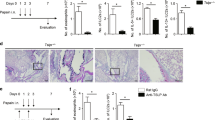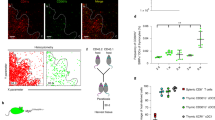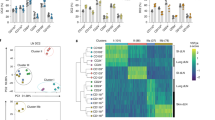Abstract
Dendritic cells (DCs) are critical in immune responses, linking innate and adaptive immunity. We found here that DC-specific deletion of the transcription factor STAT5 was not critical for development but was required for T helper type 2 (TH2), but not TH1, allergic responses in both the skin and lungs. Loss of STAT5 in DCs led to the inability to respond to thymic stromal lymphopoietin (TSLP). STAT5 was required for TSLP-dependent DC activation, including upregulation of the expression of costimulatory molecules and chemokine production. Furthermore, TH2 responses in mice with DC-specific loss of STAT5 resembled those seen in mice deficient in the receptor for TSLP. Our results show that the TSLP-STAT5 axis in DCs is a critical component for the promotion of type 2 immunity at barrier surfaces.
This is a preview of subscription content, access via your institution
Access options
Subscribe to this journal
Receive 12 print issues and online access
$209.00 per year
only $17.42 per issue
Buy this article
- Purchase on Springer Link
- Instant access to full article PDF
Prices may be subject to local taxes which are calculated during checkout






Similar content being viewed by others
Change history
23 September 2013
In the version of this article initially published, author Daniel H. Kaplan was not included. The correct list of authors and affiliations is as follows: 1Immunology Program, Benaroya Research Institute at Virginia Mason, Seattle, Washington, USA. 2Department of Immunology, University of Washington School of Medicine, Seattle, Washington, USA. 3Eppley Institute for Research in Cancer and Allied Diseases, University of Nebraska Medical Center, Omaha, Nebraska, USA. 4Center for Immunology, Department of Dermatology, University of Minnesota, Minneapolis, Minnesota, USA. 5Department of Microbiology and Immunology, Columbia University Medical Center, New York, New York, USA. 6Laboratory of Genetics and Physiology, US National Institutes of Health, Bethesda, Maryland, USA. 7These authors contributed equally to this work. Correspondence should be addressed to S.F.Z. (sziegler@benaroyaresearch.org). The Acknowledgments section should not include the first acknowledgement and should begin "We thank I. Förster..."; the Author Contributions section should include Daniel H. Kaplan's contributions as follows: "D.H.K., K.S., K.-U.W., B.R. and L.H. provided mouse strains and expertise;...." The error has been corrected in the HTML and PDF versions of the article.
References
Shortman, K. & Naik, S.H. Steady-state and inflammatory dendritic-cell development. Nat. Rev. Immunol. 7, 19–30 (2007).
McKenna, H.J. et al. Mice lacking flt3 ligand have deficient hematopoiesis affecting hematopoietic progenitor cells, dendritic cells, and natural killer cells. Blood 95, 3489–3497 (2000).
Laouar, Y., Welte, T., Fu, X.Y. & Flavell, R.A. STAT3 is required for Flt3L-dependent dendritic cell differentiation. Immunity 19, 903–912 (2003).
Onai, N., Obata-Onai, A., Tussiwand, R., Lanzavecchia, A. & Manz, M.G. Activation of the Flt3 signal transduction cascade rescues and enhances type I interferon-producing and dendritic cell development. J. Exp. Med. 203, 227–238 (2006).
Esashi, E. et al. The signal transducer STAT5 inhibits plasmacytoid dendritic cell development by suppressing transcription factor IRF8. Immunity 28, 509–520 (2008).
Schiavoni, G. et al. ICSBP is essential for the development of mouse type I interferon-producing cells and for the generation and activation of CD8α+ dendritic cells. J. Exp. Med. 196, 1415–1425 (2002).
Zenke, M. & Hieronymus, T. Towards an understanding of the transcription factor network of dendritic cell development. Trends Immunol. 27, 140–145 (2006).
Ziegler, S.F. & Artis, D. Sensing the outside world: TSLP regulates barrier immunity. Nat. Immunol. 11, 289–293 (2010).
Liu, Y.J. et al. TSLP: an epithelial cell cytokine that regulates T cell differentiation by conditioning dendritic cell maturation. Annu. Rev. Immunol. 25, 193–219 (2007).
Rochman, Y. et al. Thymic stromal lymphopoietin-mediated STAT5 phosphorylation via kinases JAK1 and JAK2 reveals a key difference from IL-7-induced signaling. Proc. Natl. Acad. Sci. USA 107, 19455–19460 (2010).
Arima, K. et al. Distinct signal codes generate dendritic cell functional plasticity. Sci. Signal. 3, ra4 (2010).
Isaksen, D.E. et al. Requirement for stat5 in thymic stromal lymphopoietin-mediated signal transduction. J. Immunol. 163, 5971–5977 (1999).
Levin, S.D. et al. Thymic stromal lymphopoietin: a cytokine that promotes the development of IgM+ B cells in vitro and signals via a novel mechanism. J. Immunol. 162, 677–683 (1999).
Isaksen, D.E. et al. Uncoupling of proliferation and Stat5 activation in thymic stromal lymphopoietin-mediated signal transduction. J. Immunol. 168, 3288–3294 (2002).
Rochman, Y., Spolski, R. & Leonard, W.J. New insights into the regulation of T cells by γc family cytokines. Nat. Rev. Immunol. 9, 480–490 (2009).
Kitajima, M., Lee, H.C., Nakayama, T. & Ziegler, S.F. TSLP enhances the function of helper type 2 cells. Eur. J. Immunol. 41, 1862–1871 (2011).
Al-Shami, A., Spolski, R., Kelly, J., Keane-Myers, A. & Leonard, W.J. A role for TSLP in the development of inflammation in an asthma model. J. Exp. Med. 202, 829–839 (2005).
He, R. et al. TSLP acts on infiltrating effector T cells to drive allergic skin inflammation. Proc. Natl. Acad. Sci. USA 105, 11875–11880 (2008).
Larson, R.P. et al. Dibutyl phthalate-induced thymic stromal lymphopoietin is required for th2 contact hypersensitivity responses. J. Immunol. 184, 2974–2984 (2010).
Soumelis, V. et al. Human epithelial cells trigger dendritic cell mediated allergic inflammation by producing TSLP. Nat. Immunol. 3, 673–680 (2002).
Henri, S. et al. Disentangling the complexity of the skin dendritic cell network. Immunol. Cell Biol. 88, 366–375 (2010).
Merad, M. & Manz, M.G. Dendritic cell homeostasis. Blood 113, 3418–3427 (2009).
Melillo, J.A. et al. Dendritic cell (DC)-specific targeting reveals Stat3 as a negative regulator of DC function. J. Immunol. 184, 2638–2645 (2010).
Gorbachev, A.V. & Fairchild, R.L. Induction and regulation of T-cell priming for contact hypersensitivity. Crit. Rev. Immunol. 21, 451–472 (2001).
Takeshita, K., Yamasaki, T., Akira, S., Gantner, F. & Bacon, K.B. Essential role of MHC II-independent CD4+ T cells, IL-4, and STAT6 in contact hypesensitivity induced by fluorscein isothiocyanate in the mouse. Int. Immunol. 16, 685–695 (2004).
Dearman, R.J. & Kimber, I. Role of CD4+ T helper 2-type cells in cutaneous inflammatory responses induced by flourscein isothiocyanate. Immunology 101, 442–451 (2000).
Bobr, A. et al. Acute ablation of Langerhans cells enhances skin immune responses. J. Immunol. 185, 4724–4728 (2010).
Zhou, B. et al. Thymic stromal lymphopoietin as a key initiator of allergic airway inflammation in mice. Nat. Immunol. 6, 1047–1053 (2005).
Headley, M.B. et al. TSLP conditions the lung immune environment for the generation of pathogenic innate and antigen-specific adaptive immune responses. J. Immunol. 182, 1641–1647 (2009).
Taylor, B.C. et al. TSLP regulates intestinal immunity and inflammation in mouse models of helminth infection and colitis. J. Exp. Med. 206, 655–667 (2009).
Ito, T. et al. TSLP-activated dendritic cells induce an inflammatory T helper type 2 cell response through OX40 ligand. J. Exp. Med. 202, 1213–1223 (2005).
Ziegler, S.F. The role of thymic stromal lymphopoietin (TSLP) in allergic disorders. Curr. Opin. Immunol. 22, 795–799 (2010).
Alferink, J. et al. Compartmentalized production of CCL17 in vivo: Strong inducibility in peripheral dendritic cells contrasts selective absence from the spleen. J. Exp. Med. 197, 585–599 (2003).
Caton, M.L., Smith-Raska, M.R. & Reizis, B. Notch-RBP-J signaling controls the homeostasis of CD8- dendritic cells in the spleen. J. Exp. Med. 204, 1653–1664 (2007).
Birnberg, T. et al. Lack of conventional dendritic cells is compatible with normal development and T cell homeostasis, but causes myeloid proliferative syndrome. Immunity 29, 986–997 (2008).
Ohnmacht, C. et al. Constitutive ablation of dendritic cells breaks self-tolerance of CD4 T cells and results in spontaneous fatal autoimmunity. J. Exp. Med. 206, 549–559 (2009).
Yoo, J. et al. Spontaneous atopic dermatitis in mice expressing an inducible thymic stromal lymphopoietin transgene specifically in the skin. J. Exp. Med. 202, 541–549 (2005).
Li, M. et al. Topical vitamin D3 and low-calcemic analogs induce thymic stromal lymphopoietin in mouse keratinocytes and trigger an atopic dermatitis. Proc. Natl. Acad. Sci. USA 103, 11736–11741 (2006).
Briot, A. et al. Kallikrein 5 induces atopic dermatitis-like lesions through PAR2-mediated thymic stromal lymphopoietin expression in Netherton syndrome. J. Exp. Med. 206, 1135–1147 (2009).
Dumortier, A. et al. Atopic dermatitis-like disease and associated lethal myeloproliferative disorder arise from loss of notch signaling in the murine skin. PLoS ONE 5, e9258 (2010).
Luche, H., Weber, O., Nageswara-Rao, T., Blum, C. & Fehling, H.J. Faithful activation of an extra-bright red fluorescent protein in “knock-in” Cre-reporter mice ideally suited for lineage tracing studies. Eur. J. Immunol. 37, 43–53 (2007).
Cui, Y. et al. Inactivation of Stat5 in mouse mammary epithelium during pregnancy reveals distinct functions in cell proliferation, survival, and differentiation. Mol. Cell Biol. 24, 8037–8047 (2004).
Kaplan, D.H., Jenison, M.C., Saeland, S., Shlomchik, W.D. & Shlomchik, M.J. Epidermal Langerhans cell-deficient mice develop enhanced contact hypersensitivity. Immunity 23, 611–620 (2005).
Murphy, K.M., Heimberger, A.B. & Loh, D.Y. Induction by antigen of intrathymic apoptosis of CD4+CD8+ TCRlo thymocytes in vivo. Science 250, 1720–1723 (1990).
Lutz, M.B. et al. An advanced culture method for generating large quantities of highly pure dendritic cells from mouse bone marrow. J. Immunol. Methods 223, 77–92 (1999).
Omori, M. & Ziegler, S. Induction of IL-4 expression in CD4+ T cells by thymic stromal lymphopoietin. J. Immunol. 178, 1396–1404 (2007).
Bell, B.D. et al. FADD and caspase-8 control the outcome of autophagic signaling in proliferating T cells. Proc. Natl. Acad. Sci. USA 105, 16677–16682 (2008).
Acknowledgements
We thank I. Förster (University of Bonn) for mice with a transgene encoding GFP in the Ccl17 locus; T. Nakayama (Chiba University) for pMX-Cre-IRES-GFP; D. Rawlings and H. Kerns (Seattle Children's Research Institute) for Btk- and Tec-deficient bone marrow; J. Hamerman and D. Campbell for discussions of the manuscript; S. Ma and W. Xu for technical support; and M. Warren and S. McCarty for administrative support. Supported by the US National Institutes of Health (R01-AI068731, R01-AR056113, R01-AR055695 and P01-HL098067 to S.F.Z., and 5T32AI007411-19 to B.D.B.).
Author information
Authors and Affiliations
Contributions
B.D.B. and M.K. did most of the experiments and wrote the manuscript, with help from S.F.Z.; D.H.K., K.S., K.-U.W., B.R. and L.H. provided mouse strains and expertise; R.P.L. collaborated on the CHS studies; T.A.S. did the influenza infections and analyzed the response to infection; K.D. provided help with bioinformatics; and S.F.Z. supervised the work.
Corresponding author
Ethics declarations
Competing interests
The authors declare no competing financial interests.
Supplementary information
Supplementary Text and Figures
Supplementary Figures 1–6 (PDF 584 kb)
Rights and permissions
About this article
Cite this article
Bell, B., Kitajima, M., Larson, R. et al. The transcription factor STAT5 is critical in dendritic cells for the development of TH2 but not TH1 responses. Nat Immunol 14, 364–371 (2013). https://doi.org/10.1038/ni.2541
Received:
Accepted:
Published:
Issue Date:
DOI: https://doi.org/10.1038/ni.2541
This article is cited by
-
Epithelial cell-derived cytokine TSLP activates regulatory T cells by enhancing fatty acid uptake
Scientific Reports (2023)
-
Preclinical development of 1B7/CD3, a novel anti-TSLPR bispecific antibody that targets CRLF2-rearranged Ph-like B-ALL
Leukemia (2023)
-
The kinase p38α functions in dendritic cells to regulate Th2-cell differentiation and allergic inflammation
Cellular & Molecular Immunology (2022)
-
STAT5 is activated in macrophages by breast cancer cell-derived factors and regulates macrophage function in the tumor microenvironment
Breast Cancer Research (2021)
-
Acute and subacute oral administration of mycotoxin deoxynivalenol exacerbates the pro-inflammatory and pro-pruritic responses in a mouse model of allergic dermatitis
Archives of Toxicology (2020)



